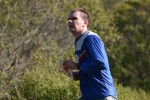Huddart Park
Date: (Sun.) Nov. 7, 2021
Location: Woodside, CA
Event Director: - 650.906.9672
Course Setter: John Richardson
Type: B; Standard 7-course B-meet in this beautiful redwood park
Related Event Information
Course Setter’s Notes
By John Richardson
After a 3-year hiatus, we return to rugged, but beautiful, Huddart Park for our first forested courses south of the Golden Gate since before the pandemic. We hope you will enjoy a day in the redwoods with the deer and abundant woodpeckers.
The Registration area is located at the Zwierlein Picnic Area, easily accessible from any of the parking areas around the loop that starts about 200 m (~1/8 mi) after the park entrance. The Start is a short walk (200 m) from the Registration area; the Finish is right across the road. See the main event page for the latest details on facilities and COVID-19 regulations.
Note: We previously stated that no water will be available on the courses. That has changed; there will be water on all except the White and Yellow courses. Of course, you’re welcome to carry your own if you want.
Remember that Daylight Saving Time ends at 2:00 AM the day of this event (i.e., be sure to “fall backâ€).
Late addition: Be aware that trail-run organizers have put out some streamers and “Wrong Way†signs around the major park trails. You can ignore them—you are free (if not encouraged!) to go the “wrong wayâ€.
Course Details
This will be a standard B-meet with 7 courses to choose from. Here are the final course details:
Navigation Course Length Climb Controls
Beginner White 1.9 km 115 m 11
Yellow 2.2 km 135 m 11
Intermediate Orange 3.3 km 215 m 10
Advanced Brown 2.6 km 165 m 8
Green 3.7 km 270 m 12
Red 5.3 km 405 m 14
Blue 6.4 km 485 m 18
Note that the course lengths above are “as the crow flies†(i.e., along straight lines between controls), and you should prepare to cover at least 50% more distance depending on your route choices. A good rule of thumb is to read “km†as “milesâ€. Advanced courses present many options between short-but-steep and longer-but-flatter routes. The climb numbers given here are for a balanced route choice somewhere between the two extremes.
People on the White and Yellow courses are advised to wear sturdy running or hiking shoes. The intermediate and advanced courses are best tackled with cleats, but hiking shoes with aggressive tread would be a good alternative. There is plenty of undergrowth on the advanced courses, so you may prefer to wear long pants and/or gaiters.
The visibility is much lower than other parks we frequent, and it can take time to realize you have taken the wrong trail. It is recommended that younger children be accompanied, and the White course may prove challenging terrain for strollers or wheelchairs. Please make sure to report to the Finish even if you have not completed your course, so we don’t have to go looking for you!
Hazards
The main event page covers the major park hazards, including steepness and poison oak (although it is easy to avoid the latter), and mandatory etiquette for yielding to horses. Additional hazards specific to the courses are listed below:
All courses: Do not enter the out-of-bounds areas, including the archery range, mapped with black hatching. There is also a deep gully mapped with purple hatching, crossed by a damaged bridge that is signposted as out-of-bounds. All the courses, except White and Yellow, go near this area—please do not attempt to cross the gully.
Green course This course requires crossing Kings Mountain Road, which is used by both motor vehicles and bicycles. There is no designated crossing point, so be careful to check that the road is clear, and pay attention to your surroundings, especially near the park entrance.
Red & Blue courses: There are some options to cross some very steep reentrants. Please exercise appropriate caution if you want to attempt these route choices.
Map Features
Thanks to Bill Cusworth, we now have vegetation mapped based on fairly recent LIDAR data, and we hope you will notice a large improvement over the map used at our last event in 2018. The distinction between white and light green is not always perfectly clear, and in practice much of the terrain is somewhere between the two. Large patches of dark green are mostly impenetrable.
A special feature of the park is redwood “fairy†rings. These are mapped with the vegetation boundary symbol as black dotted ellipses, and use the circular “prominent feature†symbol in control descriptions. Not all rings are explicitly marked on the map.
Other special vegetation symbols include the green O for distinct tree (no particular category or species) and green × for large fallen tree or stump. Brown triangles denote large rootstocks, usually of redwoods.
There is some variation in the size of mapped boulders, and approximate heights are provided in control descriptions. Generally the mapped boulders are the most prominent ones in the nearby area, so may be relatively larger/smaller than boulders mapped in other parts of the park. The difference between “boulder clustersâ€, “boulder fieldsâ€, and “stony ground†is up to some interpretation when it comes to smaller rocks.
Closing Notes
We hope you have a great time getting lost in the woods! Finally, many thanks to Nick Corsano and Dan Greene for their valuable suggestions on the courses, and to Nick for his map corrections and further vegetation improvements.

